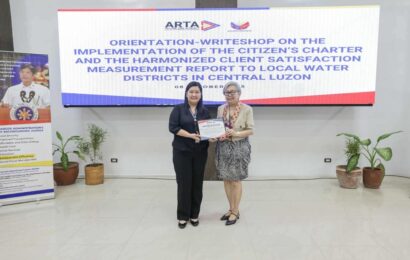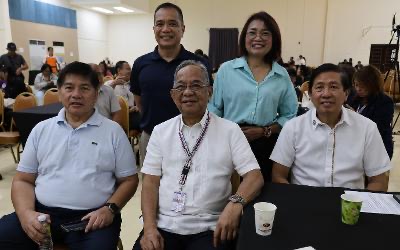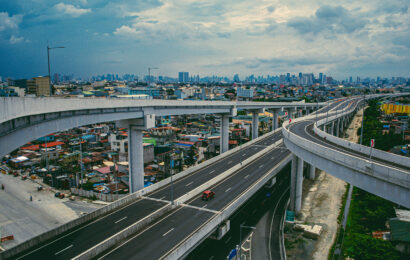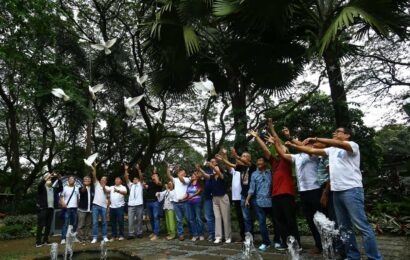AS the pandemic winds downs, San Miguel Corporation (SMC), through its San Miguel Aerocity Inc (SMAI), is forging ahead with livelihood restoration and improvement initiatives for communities in and around the site of its New Manila International Airport (NMIA) project in Bulacan — a project that is seen to bring inclusive growth for the province, post-pandemic.
SMC president and chief executive officer Ramon S. Ang said that the company recently implemented new programs aimed at helping ensure communities throughout Bulacan will benefit from both the airport’s construction and operations.
This, as townsfolk from Bulakan, Bulacan, the airport’s site, along with various organizations, reaffirmed their support for the project, saying it will bring jobs, better income opportunities, and meaningful development that will turn their province into a major aviation and investment hub in Southeast Asia.
“Maraming mamamayan ng Bulakan at mga karatig-bayan ang magkakaroon ng hanapbuhay na pang-matagalan at kasanayan sa iba’t-ibang uri ng trabaho. Maraming mamumuhunan ang darating sa ating bayan (Many citizens of Bulakan and nearby towns will benefit from long-term jobs and gain experience in different fields. Many will also come to invest in our province),” said Bulakan Mayor Vergel Meneses.
He added: “Kakailanganin po natin ang programang pang-kabuhayan lalo na para sa ating mga mangingisda at magsasaka. Ang pagpapatayo ng mga iba’t ibang pasilidad at establisimento ay makakatulong sa ating mga manggagawa, na hindi na kakailanganing mangibang-bansa. Lalakas din ang Turismo na maaaring magsulong sa mga lokal na industriya, tulad ng pangingisda (We need livelihood programs, especially for our fishermen and farmers. The building of facilities and establishments will be a big help to our workers, who will no longer need to go abroad. Tourism will also improve, and will boost local industries such as fishing).”
Building the project around engagement
SMC has been working with various key stakeholders to discuss and address social and environmental issues crucial to the delivery of a sustainable infrastructure.
Together with local government officials, SMAI recently met with some 19 non-government organizations representing several sectors in Bulacan, particularly in fishing and agriculture, to apprise them about initial site activities that airport project site in Barangay Taliptip.
The organizations include: Kababaihan Sama-Sama sa Bulakan, Knights of Columbus of Bambang Council 8677, Solo Parents Federation Association, Samahan ng Mangingisda ng Sta. Ana (SAMASA), Samahang ng Mangingisda sa Bambang (SAMABA), Samahang Isang Lahi Kabalikat sa Pagsulong ng Bulakan, Inc. (SIKAP), AKSAHO Irrigators Association, Hen. Goyo Farmers Association, Samahan ng Mangigisda ng Taliptip (SMT), Hulo-Gitna Macapatan Irrigators Association, Inc., Bulacan Young Achievers Scholarship Foundation, Inc.,
Also expressing support for the project were Gintong Nagdarang Irrigators Association, Bagong Pag-asa ng Mangingisda ng Perez, Samahang ng Magsasaka ng Bambang Irrigators Association Inc., Samahan ng Mangingisda ng San Nicolas at Sitio Babangad (SAMASAB), Samahan ng Mangingisda ng Tibig (SAMANTI), D’ Generals Bulakan Riders Association, Rotary Club of Bulakan, Bulacan No. 21847 District 3770, and Bulakan, Bulacan Transport Club, Inc.
Apart from stakeholders from Bulacan, SMAI also engages various non-governmental organizations (NGO) such as Haribon Foundation, Wildbird Club of the Philippines, Wetlands International Philippines and Center for Conservation Innovation, among others, to ensure that biodiversity in and around the project site is protected and enhanced.
Mott MacDonald, a leading international E&S consultancy firm, said it is proud to be supporting SMAI in its commitment to develop the airport project in accordance with global environmental and social performance standards and best practice, and amid the challenges of the lingering pandemic.
“Our focus is to put in place programs that will not only strengthen the communities we serve but also protect and enhance biodiversity. Apart from the airport project being our biggest investment to date, it will be our legacy to future generations. We will make sure that we do this right,” Ang said.
He added: “For close to three years now, we have also been introducing social programs in phases–first housing relocation, followed by skills training, livelihood opportunities, and then enhanced programs to support all of these. Our goal is to help build our communities up to be capable and resilient, with significantly better economic prospects than when we first met them.”
Rodolfo de la Cruz, head of Samahang Mangingisda ng Bambang, said: “Nagpapasalamat po kami sa mga tulong na ibinibigay ng San Miguel sa amin. Sana po ay tuluyang ma-prioritize ang mga mangingisda, lalong-lalo na ang Bambang, sa mga benepisyo at mga kabuhayan kung saan makikinabang ang aming mga asawa at anak (We are grateful for the help that San Miguel has been giving us. We hope that they will continue to prioritize fishermen, especially those of us in Barangay Bambang, when it comes to livelihood which will also benefit our wives and children).”
In a recent awareness and trust survey of selected personalities and groups of companies conducted by Pulse Asia, SMC came out as the top business group with the highest trust rating of in Bulacan province.

Skills training, livelihood
As part of its livelihood restoration efforts, SMC recently provided some 198 graduates of its SMC Entrepreneurship Training program, with initial business startup capital, to be able to start or expand their own small businesses.
It also launched its SMC Education Assistance Program last December, which initially benefited 81 students belonging to 185 relocatee-families.
Meanwhile, a total of fourteen (14) graduates of a Heavy Equipment Operations (HEO) course under a partnership between SMC and the Technical Education and Skills Development Authority (TESDA) have been employed at SMC’s Tullahan and Pasig River River Rehabilitation projects.
Since October 2021, the SMC-TESDA program has produced a total of 580 graduates from both school-based and community-based training programs.
Other courses offered are Electrical Installation and Maintenance, Shielded Metal Arc Welding (SMAW), and, for those looking to but up small businesses, Dressmaking, Beads and Accessories Making Training, Cooking, and Bread and Pastry Production.
Another thirty six (36) Bulacan residents were hired by SMC contractor Boskalis for the airport project, with 77 more in the process of completing their pre-employment and quarantine requirements.
SMC also recently purchased 30 boats purchased, nine of which have been turned over to the Bantay Dagat or the Municipal Fisheries and Aquatic Resources Council (MFARMC) of Bulakan, Bulakan.
Under another program, SMC donated brand new fishnets to 175 fishermen from Barangay Masile in Malolos City and Barangay Bambang in Bulakan.

Housing
In 2019, SMC began its community programs in Bulakan with the relocation of settlers living along coastal areas in Taliptip. A total of 277 families were provided housing support.
“Bilang taga-rito sa Taliptip, saksi ako na talagang mahirap ang kanilang buhay kaya’t malaking bagay ang maitayo ang airport dito. Karamihan po dito ay mga dating fishpond workers na walang pirmihan na hanapbuhay. Sa totoo lang, kung hindi pa dumating ang San Miguel ay hindi pa matutupad ang pangarap nilang magkaroon ng sariling bahay at magkakaroon ng training. Patuloy silang tumutulong hanggang ngayon (As a local, I’ve witnessed how hard life is here in Taliptip, that’s why the airport will be a big help. Many of the people here are former fishpond workers, with no permanent jobs. If San Miguel didn’t come, they would never have realized their dream of having their own homes. SMC continues to help even now),” said Michael Ramos, chairman of Barangay Taliptip.





